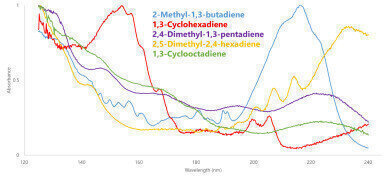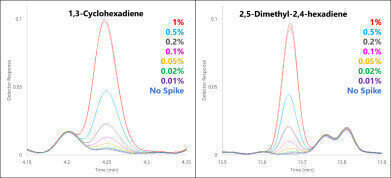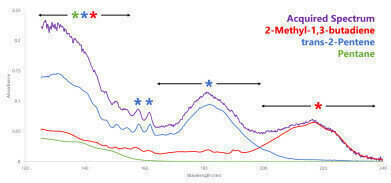-
 Figure 1. Not only are these 5 conjugated diolefin spectra distinct from one another, they also all have good VUV response at >200 nm, which allows us to easily find them in a complex matrix.
Figure 1. Not only are these 5 conjugated diolefin spectra distinct from one another, they also all have good VUV response at >200 nm, which allows us to easily find them in a complex matrix. -
 Figure 2. Taking a closer look at two of the spiked conjugated diolefins, they not only show good repeatability but also track well in detector response down to 0.02-0.05%.
Figure 2. Taking a closer look at two of the spiked conjugated diolefins, they not only show good repeatability but also track well in detector response down to 0.02-0.05%. -
 Figure 3. Even when there are several compounds co-eluting with a conjugated diolefin (2-methyl-1,3-butadiene), its spectrum has a unique response in a different wavelength region, making identification straightforward and quantitation accurate.
Figure 3. Even when there are several compounds co-eluting with a conjugated diolefin (2-methyl-1,3-butadiene), its spectrum has a unique response in a different wavelength region, making identification straightforward and quantitation accurate.
Analytical Instrumentation
Reduce Conjugated Diene Blockage in Fuel Refiners with the Automated Fuels Analyser
Jun 19 2019
The Automated Fuels Analyser from VUV Analytics is quickly becoming the new industry standard for hydrocarbon analysis, combining the power of gas chromatography–vacuum ultraviolet (GC-VUV) spectroscopy with the VUV Analyse™ software platform and ASTM D8071 methodology.
Outside of the normal analytes and groups reported through D8071, GC-VUV can report certain other analyte groups. A subset of olefins that are particularly troublesome to refiners are conjugated diolefins (CDOs), also called conjugated dienes. These compounds polymerise in higher concentrations, which in hydrocarbon streams can gum up pipes and subsequently require a refinery to shut down to clean out the blockage. CDO levels must be kept below a threshold to prevent this polymerisation from happening.
One of the original methods for measuring CDO content is UOP-326, which uses maleic anhydride as a dienophile. Excess maleic anhydride is added to the fuel sample, and some amount of the maleic anhydride is consumed in a Diels-Alder reaction with the CDOs. The remaining maleic anhydride is converted to maleic acid, which is then measured by colorimetric titration.
Although UOP-326 is still used today, it has several drawbacks. The method takes over 3 hours, whether it is performed manually or automatically. Certain nucleophiles like alcohols and thiols (which are commonly found in or added to fuels) also react with maleic anhydride, positively skewing values. On the flip side, some sterically hindered diolefins like 2,5-dimethyl-2,4-hexadiene do not react at all, which negatively skews values. Because of this lack of selectivity, the method is only semiquantitative and cannot give qualitative information, like which diolefin species are present.
More recently, a wide variety of CDO measurement methods have cropped up, including derivatized GC with mass spectrometry/NCD, HPLC, SFC-UV, NMR, near-IR, and voltammetry. VUV can identify and quantitate CDOs because of the power of the absorbance spectra. These absorbance spectra demonstrate distinct spectral features above 200 nm, which means they will stand out from saturates, olefins, and mono-aromatics (Figure 1). Five CDO species were spiked into a gasoline matrix and run in duplicate under D8071 conditions. Focusing in on two of the more baseline-separated CDOs, they give a nice linear response (r2 > 0.99) from 1% down to 0.05% for C7+ and 0.02% for C6 (Figure 2).
As for the lightest CDO, 2-methyl-1,3-butadiene (also known as isoprene), it was actually detectable down to 0.01% despite co-eluting with several major analytes. This example really showcases the power of spectral deconvolution, specifically time interval deconvolution via VUV Analyze™ Software. Isoprene co-elutes with a paraffin (pentane), which absorbs out until about 160 nm, and an olefin (trans-2-pentene), which has a nice spectral feature around 180 nm but falls off around 210 nm. Thus, the 220 nm spectral feature of isoprene can never be confused with either of these compounds, allowing for high quantitative accuracy (Figure 3).
It doesn’t get much simpler than the Automated Fuels Analyser with from VUV Analytics to obtain not only the normal PIONA quantitation with speciation of BTEX, select oxygenates, and di-aromatics, but also when obtaining speciated quantitation of CDOs.
Digital Edition
PIN 25.1 Feb/March
March 2024
In This Edition Safety - The technology behind the ION Science Tiger XT - Safety with ammonia and LOHCs as hydrogen carriers Analytical Instrumentation - Discussion on new tribology te...
View all digital editions
Events
Apr 28 2024 Montreal, Quebec, Canada
Apr 30 2024 Birmingham, UK
May 03 2024 Seoul, South Korea
May 05 2024 Seville, Spain
May 06 2024 Riyadh, Saudi Arabia

















